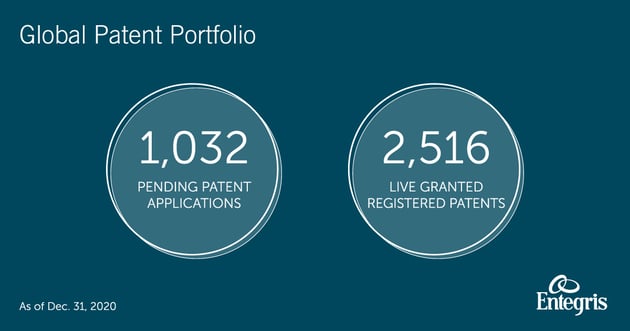To keep pace with the global demand and the rapid advancements in technology, the microelectronics industry depends heavily on innovating new solutions and processes to enable accelerated device production and performance.
At Entegris, we are very proud to honor nearly 200 employees from our global technical community for their inventions and contributions to our intellectual property in 2020.
These individuals live and work all over the world and represent each of our core semi businesses and growing life sciences market (Advanced Materials Handling, Microcontamination Control, Specialty Chemicals and Electronic Materials), and the Office of the CTO.
Together, through their dedication and expertise, they have accomplished incredible feats! We invite you to check out our full list of winners below and follow us over the next few weeks as we get to know the individuals behind the inventions. Entegris 2020 Inventors and IP Award Winners:
Entegris 2020 Inventors and IP Award Winners:
| Abuagela Rashed | Donald Frye | Juhee Yeo | Saksatha Ly |
| Aditya Verma | Doruk Yener | Jun Liu | Sally Huang |
| Akihiro Sakano | Edward Jones | Jurgen Lobert | Sarah Vogt |
| Alissa Wild | Edward Sturm | Justin Brewster | Satoshi Kamimoto |
| Alketa Gjoka | Edward Washington | Kavita Murthi | Scott Battle |
| Amelia Hart | Elango Balu | Keith Edwards | Scott Laneman |
| Amlan Chakraborty | Emanuel Cooper | Kenney Jordan | Seobong Chang |
| Amy Yang | Eric Condo | Kobold Yang | SeongJin Hong |
| Andrew Harris | Eric Hong | Kwok-Shun Cheng | Sharon Kirk |
| Angela Yu | Eric Kirkland | Laundy Oeur | Shawn Duc Nguyen |
| Anthony Dennis | Eric Tien | Lucy Dai | Shawn Eggum |
| Anthony Tieben | Francis Oberholtzer | Manuel Gonzales | Sina Bonyadi |
| Ashutosh Bhabhe | Gary Gallagher | Marco Holzner | Steven Bishop |
| Atanu Das | Gavin Richards | Mark Biscotto | Steven Bilodeau |
| Barry Chambers | George Gonnella | Mark Smith | Steven Donnell |
| Barry Gregerson | Greg Bores | Marshall Randolph | Steven Hsiao |
| Benjamin Cardozo | Han Wang | Matthew Browning | Steven Lippy |
| Benjamin Garrett | Harvey Tang | Matthew Fuller | Steven Ulanecki |
| Benjamin Olson | Hee Jun Yang | Matthew Marlow | Stuart Tison |
| Bill Shaner | Henry Wang | Megan Wu | Sundiro Zhou |
| Bob Shie | Huaping Wang | Meghan Patrick | SungHae Lee |
| Brett Reichow | Ivan Chan | Michael Schleicher | Sungsil Cho |
| Brian Gagnon | Jack Cleary | Michael Manfred | Sunny De |
| Brian Szymanski | Jacob Littfin | Michael White | Thomas Chatterton |
| Brian Wiseman | Jacob Thomas | Michael Wodjenski | Thomas Cameron |
| Bruce Garber | Jad Jaber | Michael Zabka | Thomas LeBlanc |
| Bruno Miquel | Jae Eon Park | Min-Chieh Yang | Thomas Parson |
| Bryan Hendrix | Jakub Rybcznski | Murali Bandreddi | Tony Tieben |
| Bryant Lymburn | James Hamzik | Neil Syvertson | Tracy Gast |
| Carlo Waldfried | James Lee | Nicholas Coscia | Trang Nguyen |
| Catherine Gates | James Linder | Nilesh Gunda | Troy Scoggins |
| Cesar Lopez Gonzalez | James McManus | Oleg Polyakov | Vagulejan Balasanthiran |
| Chad Wang | Jason Steffens | Oleg Byl | Victoria Weidner |
| Charles Applegarth | Jeff Kubesh | Paul Hinkle | Vinay Goel |
| Christopher Barck | Jeffery King | Paul Magoon | Vinay Kalyani |
| Christopher Reddy | Jeffrey McKenzie | Pei Zhao | Virendra Warke |
| Colton Harr | Jeffrey Upton | Phil Chen | Wai-Ming Choi |
| Conrad Suriaga | Jianan Hou | Ping Jiang | Wisma Hsu |
| Crystal Du | Joey Yang | Poshin Lee | WonLae Kim |
| Dale Maenke | John Gaudreau | Pranesh Muralidhar | Xianxin Wu |
| Daniel Elzer | John Leys | Rachel Fricker | Yan Liu |
| Daniela White | John N. Gregg | Rajiv Singh | Yasuji Suzuki |
| David Crespo | John Puglia | Rajnikant Patel | Yasushi Oyashiki |
| David Ermert | Jorgen Lundgren | Raymond Wolf | Ying Tang |
| David Kuiper | Joseph Despres | Reena Srivastava | Yiwei Lu |
| David Peters | Joseph Rivers | Rex Sheppard | YoungMin Kim |
| David Smith | Joseph Sousa | Robert Zeller | Yuki Nakamura |
| Dean Tsou | Joseph Sweeney | Robert Wright Jr | Yuxin Song |
| Deepika Singh | Joshua Cook | Rocky Gipson | Yuxuan Liu |
| Devon Nichole Dion | Joshua Jablonski | Russ Raschke |




